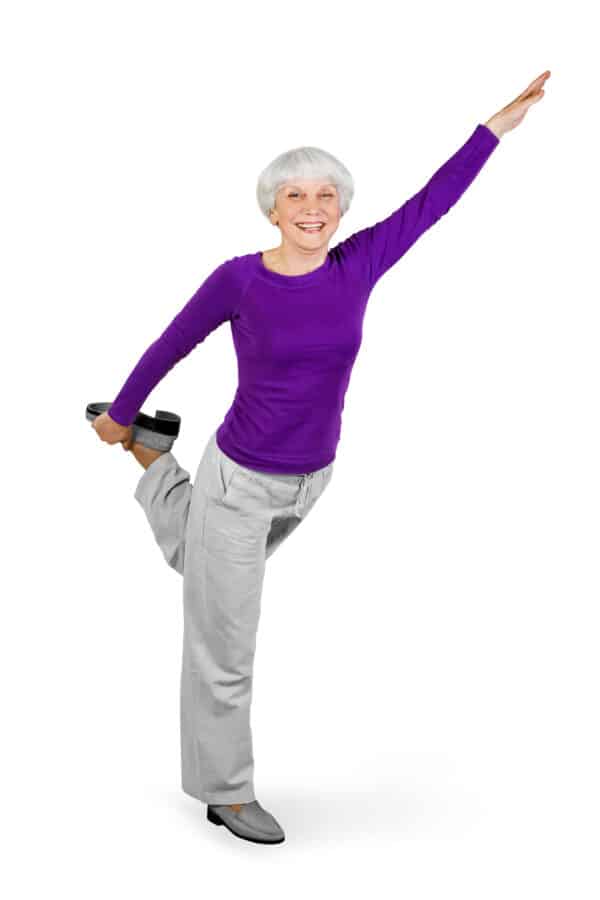Information abounds for older adults about the importance of cardio and strength training, but there’s less data available on flexibility training. However, a handful of studies do show that improving flexibility is key for increasing your comfort and longevity as you age.
Why do you need flexibility?
Flexibility refers to how easily you bend and how much range of motion you have in your joints. As we age, our muscles and tendons tighten and atrophy, and our joints become stiff, causing a reduction in flexibility. Tight muscles can act as a splint on a joint, preventing it from moving properly.
Lower flexibility makes it harder for us to do everyday things, such as:
- Sit down
- Stand up
- Roll over in bed
- Get dressed
- Take a bath or shower
- Clean the house
- Walk the dog
- Reach for items in cabinets
- Fold clothes
- Garden
Over time, loss of flexibility can seriously hamper our way of life!
It’s important for preventing falls, for one thing. Both shoulder mobility and ankle flexibility correlate with fall rates. In fact, ankle range of motion is one of the factors most closely tied to balance. The better the range of motion throughout the ankle on all planes, the less likely a person is to fall. Improving the range of motion in the ankle also leads to balance gains.
Since falls can result in significant bodily damage, we should avoid them at all costs. Increasing flexibility can make falls less likely to happen.
How to train flexibility as an older adult
In training flexibility for older adults at Heather Lane PT, we usually aim to either:
- Increase flexibility,
- Preserve existing flexibility, or
- Reduce stiffness and the aches that come with it
There may even be different goals for different joints!
Some adults practice Tai Chi or yoga to combine flexibility with coordination, stretching and toning. These exercises help prevent falls and improve cognition. Perform them under the supervision of a trained professional, especially if you’re a beginner.
Stretching exercises also help you work toward flexibility goals. For instance, lengthening calf muscles through stretching allows the ankle to align properly and move freely, which relaxes the foot and improves balance. It takes only a few minutes a day, 5 days a week for 6 weeks, to see about a 12-degree increase in an ankle’s range of motion. This can mean the difference between falling and preventing that fall!
Unless you are someone who has been stretching for a long time, it’s important to start stretching with a specialist. Qualified specialists include most physical therapists and personal trainers who focus their practice on older adults.

Because the body changes as we age, specialists will be able to help you start a stretching program in a way that is safe for you. They can also help you develop a training program that will target other goals in addition to flexibility, like:
- Gaining strength
- Increasing cardiovascular capacity
- Improving coordination
Gaining and maintaining flexibility involves a long-term commitment. When the potential gains involve avoiding falls and continuing to perform daily tasks on your own, though, it’s worth the investment of time and energy.
Citations
Johnson E, Bradley B, Witkowski K, McKee R, Telesmanic C, Chavez A, Kennedy K, Zimmerman G. Effect of a static calf muscle-tendon unit stretching program on ankle dorsiflexion range of motion of older women. J Geriatr Phys Ther. 2007;30(2):49-52. PubMed PMID: 18171487.
Lam, L. C. W., Chau, R. C. M., Wong, B.M.L., Fung, A. W. T., Tam, C. W. C., Leung, G. T. Y., Kwok, T. C. Y., Leung, T. Y. S., Ng, S. P., Chan, W. M, A 1-Year randomized controlled trial comparing mind body exercise (Tai Chi) with stretching and toning exercise on cognitive function in older Chinese adults at risk of cognitive decline. Journal of the American Medical Directors Association. 2012 13(6)568.e15-568.e20, ISSN 1525-8610, doi: 10.1016/j.jamda.2012.03.008.
Li, F., Harmer, P., Fisher, K. J., McAuley, E., Chaumeton, N., Eckstrom, E., Wilson, N. L., Tai Chi and fall reductions in older adults: a randomized controlled trial. The Journals of Gerontology: Series A. 2005 Feb;60(2):187-94. https://doi.org/10.1093/gerona/60.2.187.
Lobo A, Carvalho J, Santos P. Comparison of functional fitness in elderlies with reference values by Rikli and Jones and after one-year of health intervention programs. J Sports Med Phys Fitness. 2011 Mar;51(1):111-20. PubMed PMID: 21526574.
Mecagni C, Smith JP, Roberts KE, O’Sullivan SB. Balance and ankle range of motion in community-dwelling women aged 64 to 87 years: a correlational study.
Phys Ther. 2000 Oct;80(10):1004-11. PubMed PMID: 11002436.
Seco, J., Abecia, L. C., Echevarría, E., Barbero, I., Torres‐Unda, J., Rodriguez, V. and Calvo, J. I. (2013), A long‐term physical activity training program increases strength and flexibility, and improves balance in older adults. Rehabil Nurs, 38: 37-47. doi:10.1002/rnj.64.

